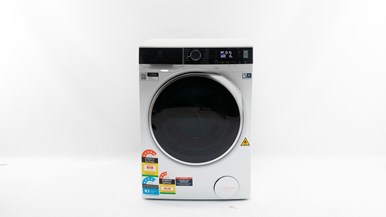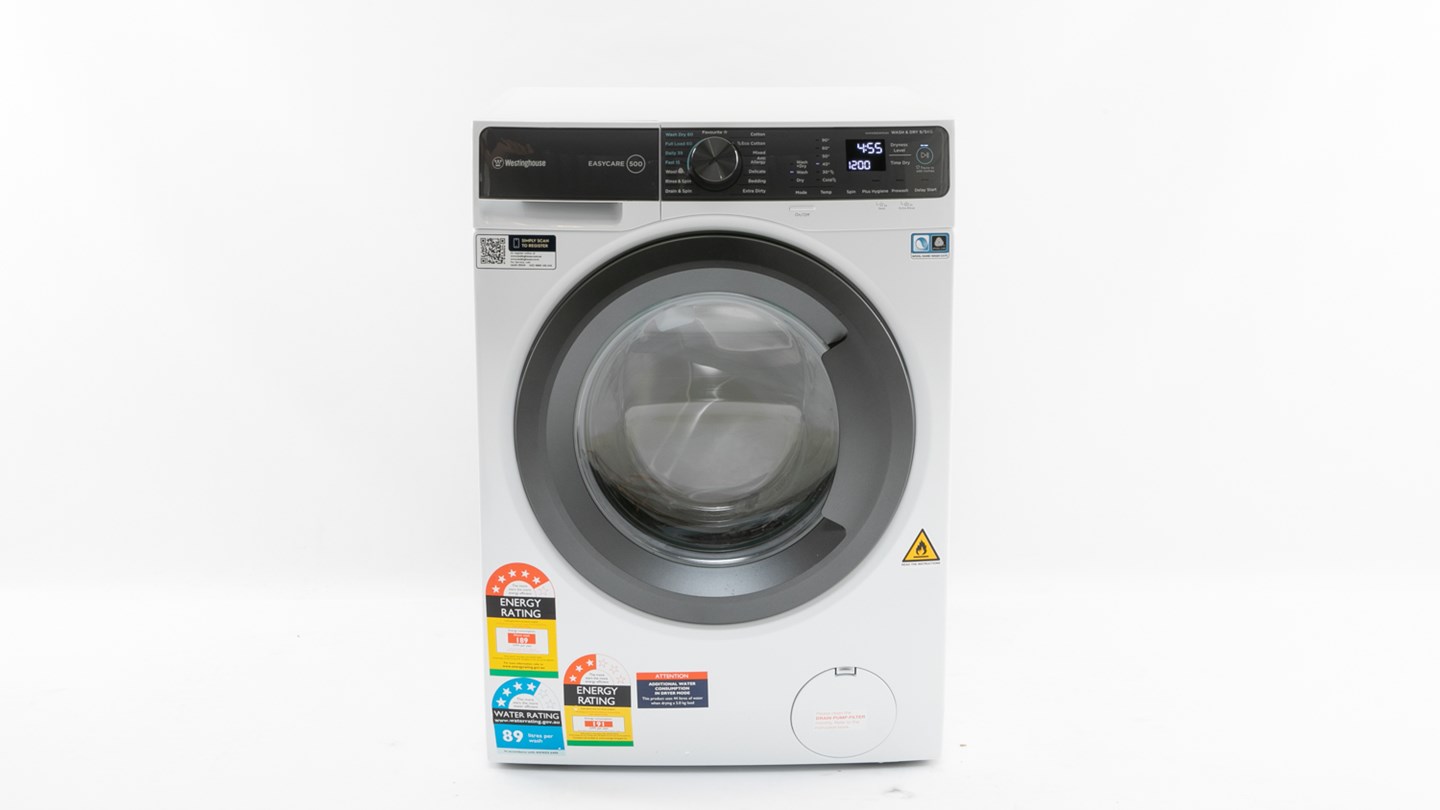Electrolux EWW1042R7WB review
10kg wash capacity. 6kg drying capacity. Priced at $1899.
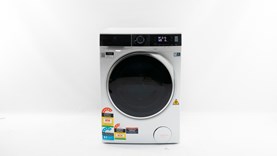
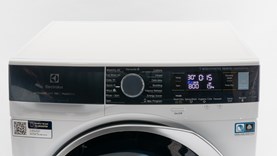

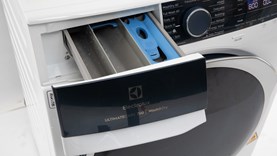
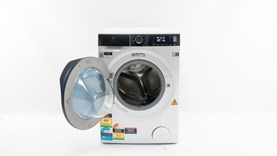
Good points
Bad points

Unlock our expert review and more
- Reviews and ratings you can trust
- Easy side-by-side comparison
- Recommended products at a glance
-
Type (washer / dryer)
View more details.
This refers to the type of washing machine and dryer. In this case, all are front loader washers and condensor dryers.
- Front / Condenser
-
Recommended
View more details.
CHOICE recommends currently available washer dryer combos that score at least 70% overall, 75% for wash performance and 60% for drying performance.
-
Long cycle time penalty
View more details.
We apply a penalty to the wash performance scores for washer dryer combos which take too long to wash. Starting at 90 minutes, the penalty increases the longer the cycle takes.
-
CHOICE Expert Rating
View more details.
The overall score is made up of wash performance (70%) and drying performance (30%).
-
Drying performance score
View more details.
The drying performance score is made up of energy efficiency (60%) and drying time (40%).
-
Wash performance score
View more details.
The wash performance score is made up of dirt removal (40%), rinse performance (20%), gentleness (15%), water efficiency (15%) and spin efficiency (10%). Models with cycle times longer than 90 minutes receive a small penalty.
-
Dirt removal score
View more details.
The machine we use to measure this (a spectrophotometer) is more accurate than the human eye; differences of about 6% are visible.
-
Rinse performance score
View more details.
This is a measure of how well the machines keep the dirt suspended in the water rather than depositing it back on the clothes, and how well they rinse out detergent. We add a marker chemical to the wash, and measure how much remains after the cycle - the less there is, the better the rinse.
-
Gentleness score
View more details.
To check for fabric wear, we attach swatches of easily frayed fabric to the garments in each load. The area of the swatch is measured before and after the wash – the less fraying, the gentler the machine.
-
Water efficiency score
View more details.
Flow meters are connected to each machine to measure water use. To compare efficiency between different-sized machines, we calculate the amount of water used per kilogram of the test load. The less water per kilogram of clothing, the higher the efficiency score.
-
Spin efficiency score
View more details.
The test load is weighed before and after each wash. The less water remaining in the clothes the higher the score, and the faster your laundry will dry. We use the machines maximum spin speed.
-
Dryer energy efficiency
View more details.
We take a 3.5kg load of dry laundry, wet it to 90% saturation and measure how much time and energy it takes to dry it. The energy efficiency and drying time scores are based on the amount of energy and time used per kilogram of clothing.
-
Drying time
View more details.
If the dryer has a sensor to determine when the clothes are dry and automatically turns off, we use it, otherwise we test using the timer. The longer the drying time, the lower the score.
-
Total water used (L)
View more details.
The total amount of water used during the entire program washer dryer cycle.
-
Total energy used (kWh)
View more details.
The amount of energy used during the entire washer dryer program cycle we selected.
-
Cycle time (mins)
View more details.
The total amount of time taken to complete the washer dryer program cycle we selected – this can vary widely, up to six hours.
-
Noise (dBA)
View more details.
The maximum noise level is recorded during the spin cycle of the tested program and is measured one metre away from the machine and one metre above the ground. Typically, these appliances are as noisy as a normal conversation (about 65dB).
-
Shop Ethical rating
View more details.
Shop Ethical rates the environmental and social impact of the company (not the product) using independent sources. This rating isn't included in our total score. N/A means there's no rating for that company.
- C
-
Reliability score
View more details.
Taken from our brand reliability survey, this does not add to the overall score. Scores refer to the brand only, not the particular model. In this case, we've used scores taken from washing machines.
-
Satisfaction score
View more details.
Taken from our brand reliability survey, this does not add to the overall score. Scores refer to the brand only, not the particular model. In this case, we've used scores from our washing machine reviews.
-
Energy label – washer energy (kWh/year)
View more details.
The energy use as stated on the label, based on 365 uses per year.
- 227
-
Energy label – dryer energy (kWh/year)
View more details.
The energy use on the label, based on 52 uses per year.
- 229
-
Energy label – wash program
View more details.
The wash program stated on the energy label of the machine. Manufacturers tend to choose a program that uses the least power and water to attain the most stars possible, even though our findings are that many people won't use this program. Most people use a normal wash.
- Energy saver, 40°C, warm wash, 1400rpm
-
Energy label – dry program
View more details.
The dry program stated on the energy label of the machine. Manufacturers tend to choose a program that uses the least power and water to attain the most stars possible, even though our findings are that many people won't use this program.
- Cottons, dry mode, extra dry
-
Energy – washer stars
View more details.
Energy star rating based on a formula that incorporates the energy used per wash and the claimed capacity of the machine in kg.
- 5
-
Energy – dryer stars
View more details.
Energy star rating based on a formula that incorporates the energy used per dry and the claimed capacity of the machine in kg.
- 3
-
Water label – wash water (L)
View more details.
A comparative measure of the water efficiency of a washing machine. The more stars, the higher the efficiency. For washer dryer combos, the label must state how much water is used for drying, but it doesn't count towards the star rating.
- 83
-
Water label – dryer water (L)
View more details.
For washer dryer combos the WELS star rating logo must display how much water is used for drying, but it doesn't count towards calculating the stars.
- 56
-
Water – washer stars
View more details.
A comparative measure of the water efficiency of a washing machine. The more stars, the higher the efficiency. For washer dryer combos, the label must state how much water is used for drying, but it doesn't count towards the star rating.
- 4.5
-
Warranty (years)
View more details.
Stated warranty of the machine - not the parts. You're still covered by the Australian Consumer Law regardless of the manufacturer warranty.
- 2
-
Country of origin
View more details.
Most models have a claimed origin somewhere on the model itself. This should be taken with a grain of salt, as it's rare that all the materials for a product came from the one country.
- Thailand
-
Price
View more details.
Recommended retail price at time of testing.
- $1899
-
Running costs over 10 years
View more details.
This is an estimate of how much it will cost for water and electricity over 10 years if you wash the equivalent of one load every day using a normal cycle and dry three times a week, based on 40 cents per kWh of electricity and $2 per 1000L for water. Running costs don't include detergent, the largest cost of running a washing machine.
-
Purchase price + running costs over 10 years
View more details.
Total cost of ownership (purchase price plus running costs over 10 years), not taking detergent into account, which is the most expensive part of doing your laundry.
-
Drying capacity (kg)
View more details.
The claimed drying capacity of a washer dryer. Note that dryer capacity is lower than the washing capacity in all machines due to the need for air to circulate when drying.
- 6
-
Wash capacity (kg)
View more details.
The claimed washing capacity of a washer dryer. Note that drying capacity is less than the washing capacity in all machines, so you may need to dry in two goes if washing a full load.
- 10
-
Tested capacity (kg)
View more details.
The weight of the washing load we used to test the machine, measured in kilograms. This shouldn't vary unless an extra run has been done on a lower claimed capacity machine.
- 3.5
-
Program tested
View more details.
We test on a normal, cold wash or the closest approximation to it. You'll sometimes see differences between what the energy and water labels say on the machine and our results, because manufacturers may have used a different program for registration.
- Cotton, cold, 1400rpm, 2:39 to go
-
Coldest wash for normal program
View more details.
Since most Australians wash in cold water, we apply a small penalty in our overall score to models that can't do a proper cold wash (our water is at 20 degrees C) on their 'normal' cycle.
- Cold
-
Tap connection
View more details.
Some machines have both hot and cold water inlets (H&C); others can connect to cold water only, and have on-board heaters for warm washes. Check the maximum temperature recommended for the hot-water inlet. Many manufacturers recommend a lower temperature than most hot-water systems deliver - particularly solar hot-water systems meaning you may need a tempering valve.
- Cold only
-
Minimum water pressure (kPa)
View more details.
Washers require a minimum water pressure for water to flow into the machine and function. Check your local water supplier for the water pressure to your house, as this will differ.
- 50
-
Maximum hot water inlet temp (°C)
View more details.
Where washers accept a hot water source, there can be a cap on how high the temperature can be before it affects the hose or internal mechanisms. Usually this can be regulated by your heater, or a tempering valve can be fixed to the inlet if your water temperature is higher than accepted.
- Not applicable
- Maximum speed (rpm)
- 1400
-
Dimensions (cm, H x W x D)
View more details.
The dimensions listed are the smallest dimensions in which the washer will fit according to the manufacturer.
- 85 x 60 x 66
- Website
- electrolux.com.au
-
Fast program
View more details.
A fast-wash option reduces the length of the selected program or is a faster cycle in itself. These programs are only suitable for small, lightly soiled loads.
- Yes
- Gentle or delicates program
- Yes
-
Auto-sensing water level
View more details.
This can help you save water, energy and time by automatically adjusting the water level according to the load and/or fabric type. Some machines also adjust the washing action.
- Not stated
-
Out-of-balance correction
View more details.
The machine automatically detects and redistributes an out-of-balance load, either by spinning slowly before the full spin cycle or by taking in more water. An imbalance usually happens when a single item (such as jeans or a towel) is put into the machine and the spin makes the machine bounce around from the weight being thrown about.
- Yes
-
Selectable spin speed
View more details.
You can change the spin speed on some programs. A higher spin speed will result in drier clothes, which dry faster and use less energy in the dryer, however lower spin speeds mean fewer creases and fluffier towels.
- Yes
- Machine washable woollens
- Yes
-
Handwash only woollens
View more details.
Some machines have an extra-gentle wash cycle for garments labelled as only suitable for handwashing - including woollens, silk and cashmere. The program uses different washing actions such as less water.
- Yes
-
Extra rinse
View more details.
An extra rinse feature can be useful if find detergent residue on your clothes, or if your skin is sensitive to detergent. Some washers have it as an extra run added to the end of a program, or as a simple single run (rinse and spin) once the primary program is finished.
- No
-
Lint filter
View more details.
Like front loaders, washer dryer combos don't need lint filters because they're gentler on clothes.
- No
-
Delay time
View more details.
'Delay time' or 'time delay' is a feature that lets you program the wash to start at a specific time in the future, to take advantage of peak solar generation time, off-peak power, or just to have your laundry finish in the morning as you're waking up.
- Yes
-
Time remaining display
View more details.
Time remaining display will give you a rough estimation of how long the load will take to wash. This can fluctuate wildly as some washers use sensors to detect how dirty your wash is, the type of load you've put in and how much you've put in to adjust the timing.
- Yes
-
Add items after start
View more details.
Most front loaders allow you to pause the wash in the first moments of pushing the start button, but after water gets to the door, its a no go unless you cancel the wash and start again.
- Yes

